Family Centred Care: Nursing Interventions and Impact on Child Health
VerifiedAdded on 2021/01/01
|12
|3110
|160
Report
AI Summary
This report examines the principles and impact of Patient and Family Centered Care (PFCC) on child health and nursing practices. It highlights the positive effects of PFCC on families and children, emphasizing collaboration and the importance of strong relationships between healthcare professionals, patients, and their families. The concepts of enabling and empowerment are explored in the context of pediatric nursing, focusing on increasing awareness, improving cost constraints, and establishing cordial relations. A comparative analysis of the 'participation' principle of PFCC is conducted using case studies, revealing instances of unprofessional behavior and communication gaps among nurses. Nursing interventions suitable for a child's developmental stage are discussed, along with strategies to reduce the negative effects of hospitalization, emphasizing the crucial role of nurses in providing support, care, and education to patients and their families. Desklib provides access to this document and many more solved assignments for students.
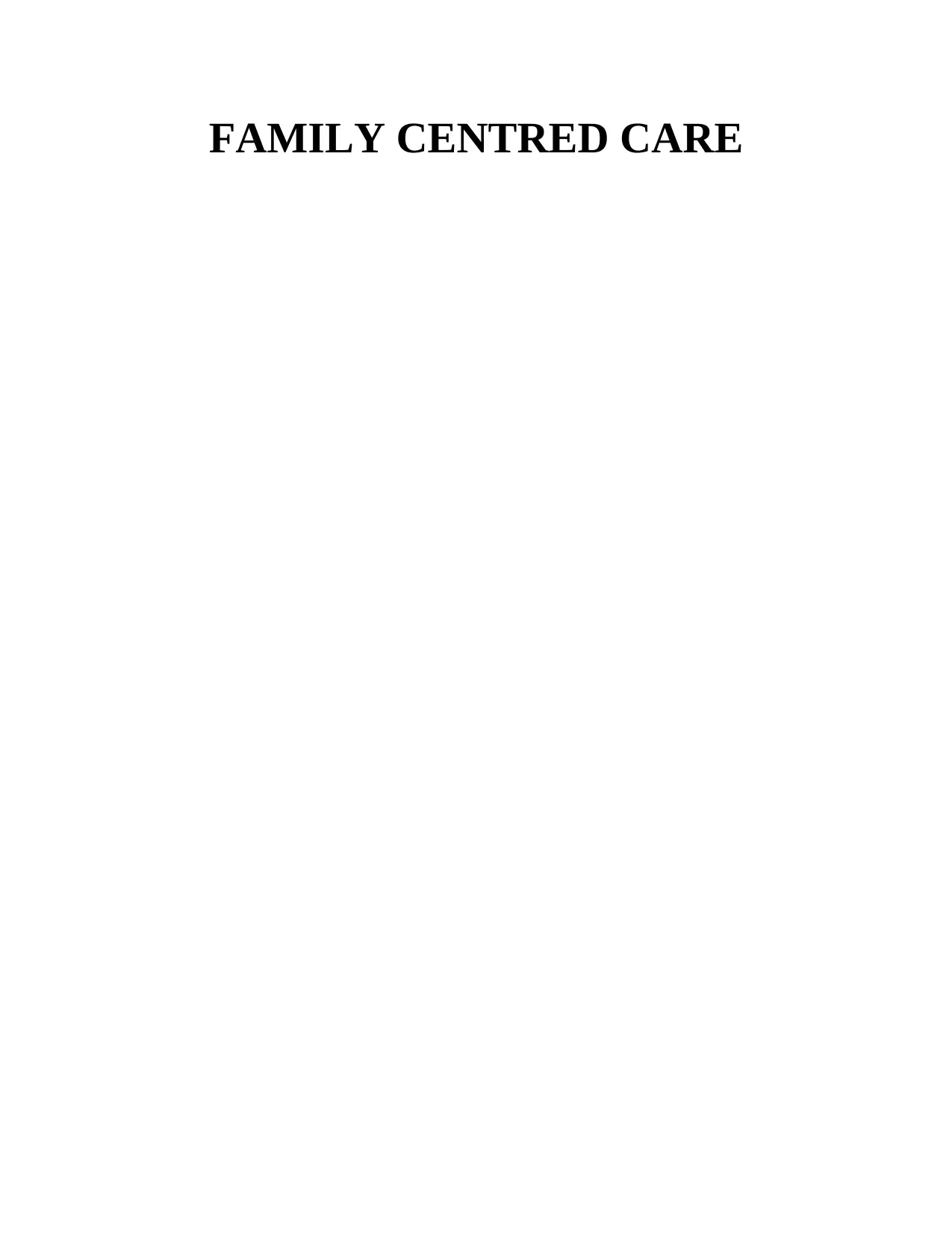
FAMILY CENTRED CARE
Paraphrase This Document
Need a fresh take? Get an instant paraphrase of this document with our AI Paraphraser
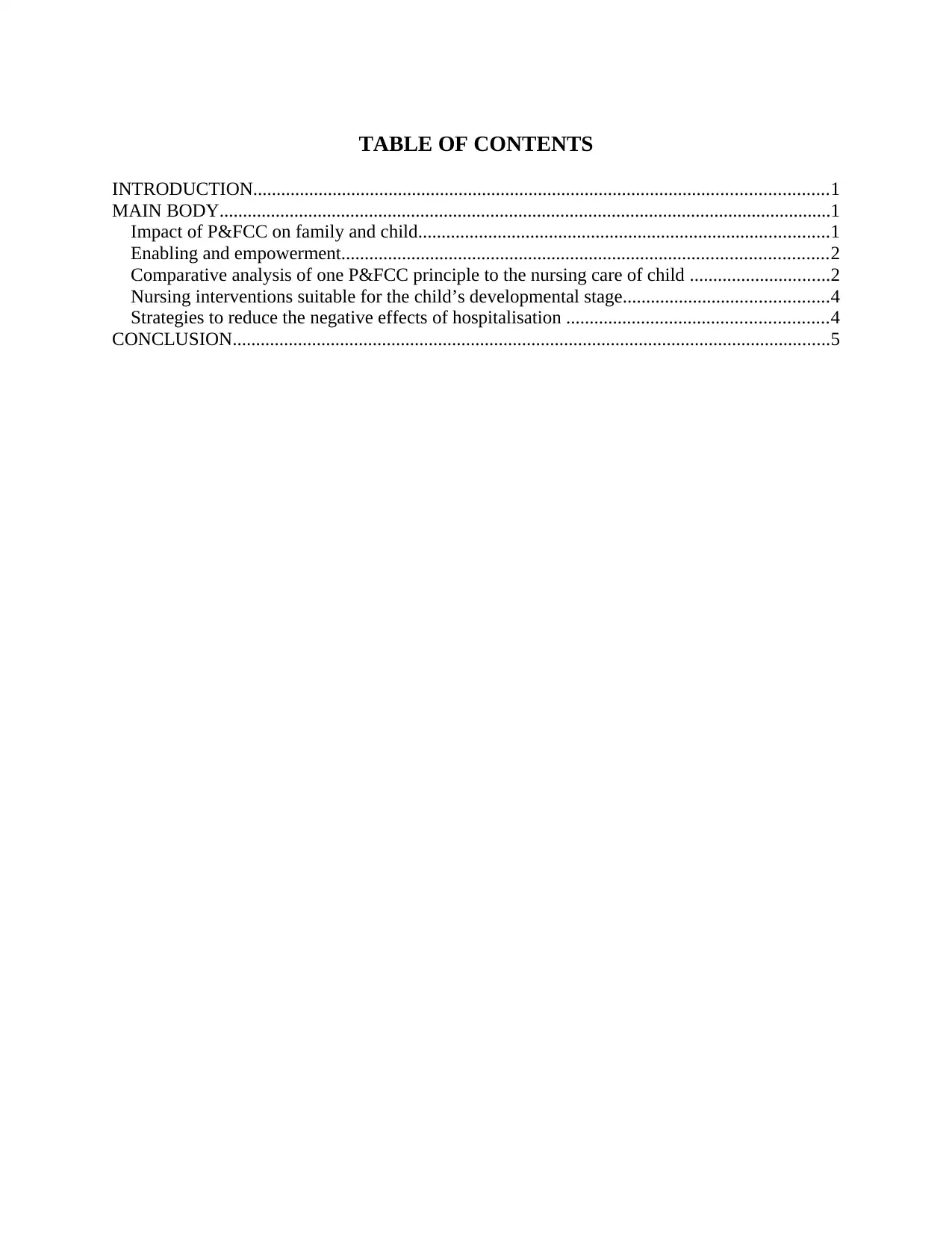
TABLE OF CONTENTS
INTRODUCTION...........................................................................................................................1
MAIN BODY...................................................................................................................................1
Impact of P&FCC on family and child........................................................................................1
Enabling and empowerment........................................................................................................2
Comparative analysis of one P&FCC principle to the nursing care of child ..............................2
Nursing interventions suitable for the child’s developmental stage............................................4
Strategies to reduce the negative effects of hospitalisation ........................................................4
CONCLUSION................................................................................................................................5
INTRODUCTION...........................................................................................................................1
MAIN BODY...................................................................................................................................1
Impact of P&FCC on family and child........................................................................................1
Enabling and empowerment........................................................................................................2
Comparative analysis of one P&FCC principle to the nursing care of child ..............................2
Nursing interventions suitable for the child’s developmental stage............................................4
Strategies to reduce the negative effects of hospitalisation ........................................................4
CONCLUSION................................................................................................................................5
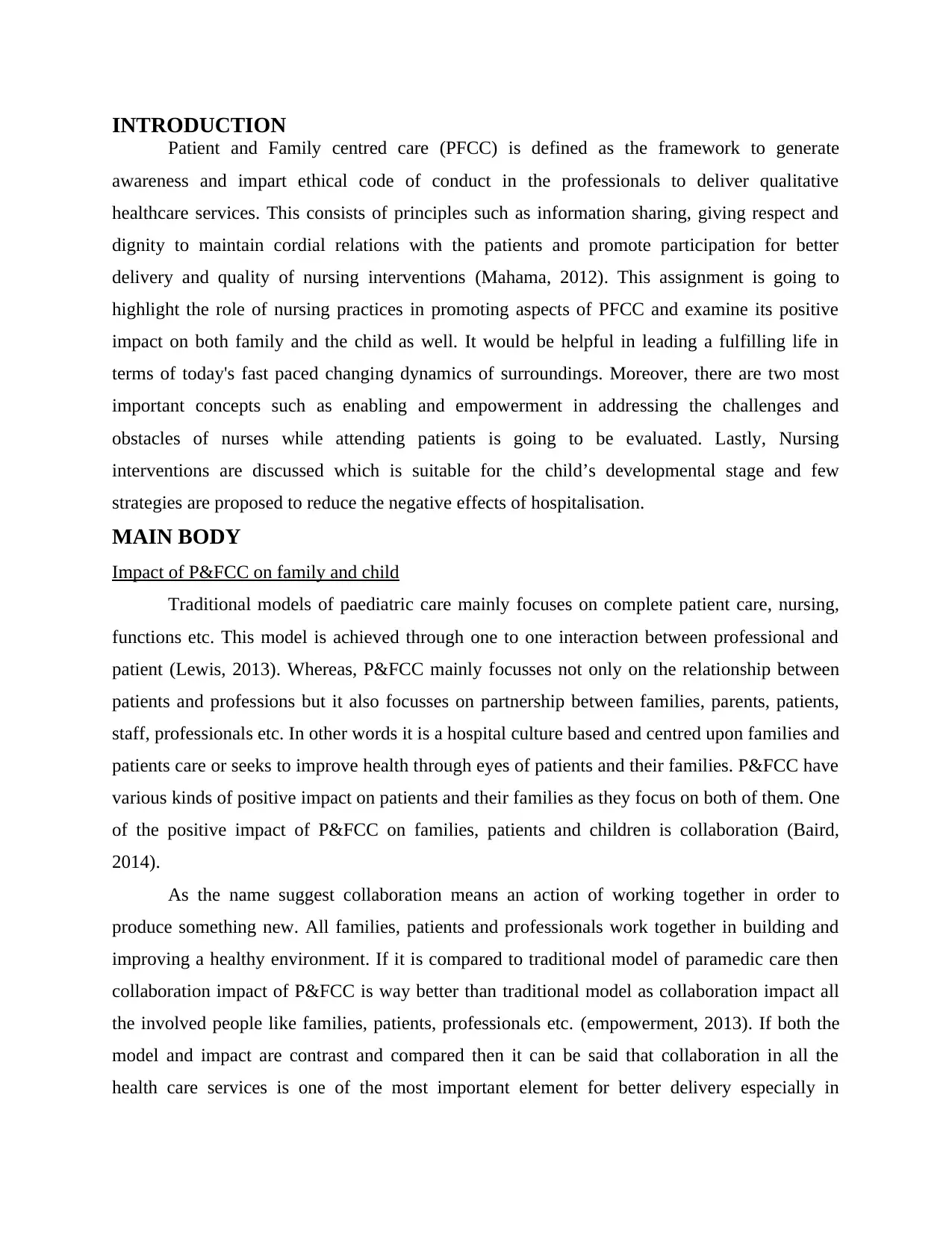
INTRODUCTION
Patient and Family centred care (PFCC) is defined as the framework to generate
awareness and impart ethical code of conduct in the professionals to deliver qualitative
healthcare services. This consists of principles such as information sharing, giving respect and
dignity to maintain cordial relations with the patients and promote participation for better
delivery and quality of nursing interventions (Mahama, 2012). This assignment is going to
highlight the role of nursing practices in promoting aspects of PFCC and examine its positive
impact on both family and the child as well. It would be helpful in leading a fulfilling life in
terms of today's fast paced changing dynamics of surroundings. Moreover, there are two most
important concepts such as enabling and empowerment in addressing the challenges and
obstacles of nurses while attending patients is going to be evaluated. Lastly, Nursing
interventions are discussed which is suitable for the child’s developmental stage and few
strategies are proposed to reduce the negative effects of hospitalisation.
MAIN BODY
Impact of P&FCC on family and child
Traditional models of paediatric care mainly focuses on complete patient care, nursing,
functions etc. This model is achieved through one to one interaction between professional and
patient (Lewis, 2013). Whereas, P&FCC mainly focusses not only on the relationship between
patients and professions but it also focusses on partnership between families, parents, patients,
staff, professionals etc. In other words it is a hospital culture based and centred upon families and
patients care or seeks to improve health through eyes of patients and their families. P&FCC have
various kinds of positive impact on patients and their families as they focus on both of them. One
of the positive impact of P&FCC on families, patients and children is collaboration (Baird,
2014).
As the name suggest collaboration means an action of working together in order to
produce something new. All families, patients and professionals work together in building and
improving a healthy environment. If it is compared to traditional model of paramedic care then
collaboration impact of P&FCC is way better than traditional model as collaboration impact all
the involved people like families, patients, professionals etc. (empowerment, 2013). If both the
model and impact are contrast and compared then it can be said that collaboration in all the
health care services is one of the most important element for better delivery especially in
Patient and Family centred care (PFCC) is defined as the framework to generate
awareness and impart ethical code of conduct in the professionals to deliver qualitative
healthcare services. This consists of principles such as information sharing, giving respect and
dignity to maintain cordial relations with the patients and promote participation for better
delivery and quality of nursing interventions (Mahama, 2012). This assignment is going to
highlight the role of nursing practices in promoting aspects of PFCC and examine its positive
impact on both family and the child as well. It would be helpful in leading a fulfilling life in
terms of today's fast paced changing dynamics of surroundings. Moreover, there are two most
important concepts such as enabling and empowerment in addressing the challenges and
obstacles of nurses while attending patients is going to be evaluated. Lastly, Nursing
interventions are discussed which is suitable for the child’s developmental stage and few
strategies are proposed to reduce the negative effects of hospitalisation.
MAIN BODY
Impact of P&FCC on family and child
Traditional models of paediatric care mainly focuses on complete patient care, nursing,
functions etc. This model is achieved through one to one interaction between professional and
patient (Lewis, 2013). Whereas, P&FCC mainly focusses not only on the relationship between
patients and professions but it also focusses on partnership between families, parents, patients,
staff, professionals etc. In other words it is a hospital culture based and centred upon families and
patients care or seeks to improve health through eyes of patients and their families. P&FCC have
various kinds of positive impact on patients and their families as they focus on both of them. One
of the positive impact of P&FCC on families, patients and children is collaboration (Baird,
2014).
As the name suggest collaboration means an action of working together in order to
produce something new. All families, patients and professionals work together in building and
improving a healthy environment. If it is compared to traditional model of paramedic care then
collaboration impact of P&FCC is way better than traditional model as collaboration impact all
the involved people like families, patients, professionals etc. (empowerment, 2013). If both the
model and impact are contrast and compared then it can be said that collaboration in all the
health care services is one of the most important element for better delivery especially in
⊘ This is a preview!⊘
Do you want full access?
Subscribe today to unlock all pages.

Trusted by 1+ million students worldwide
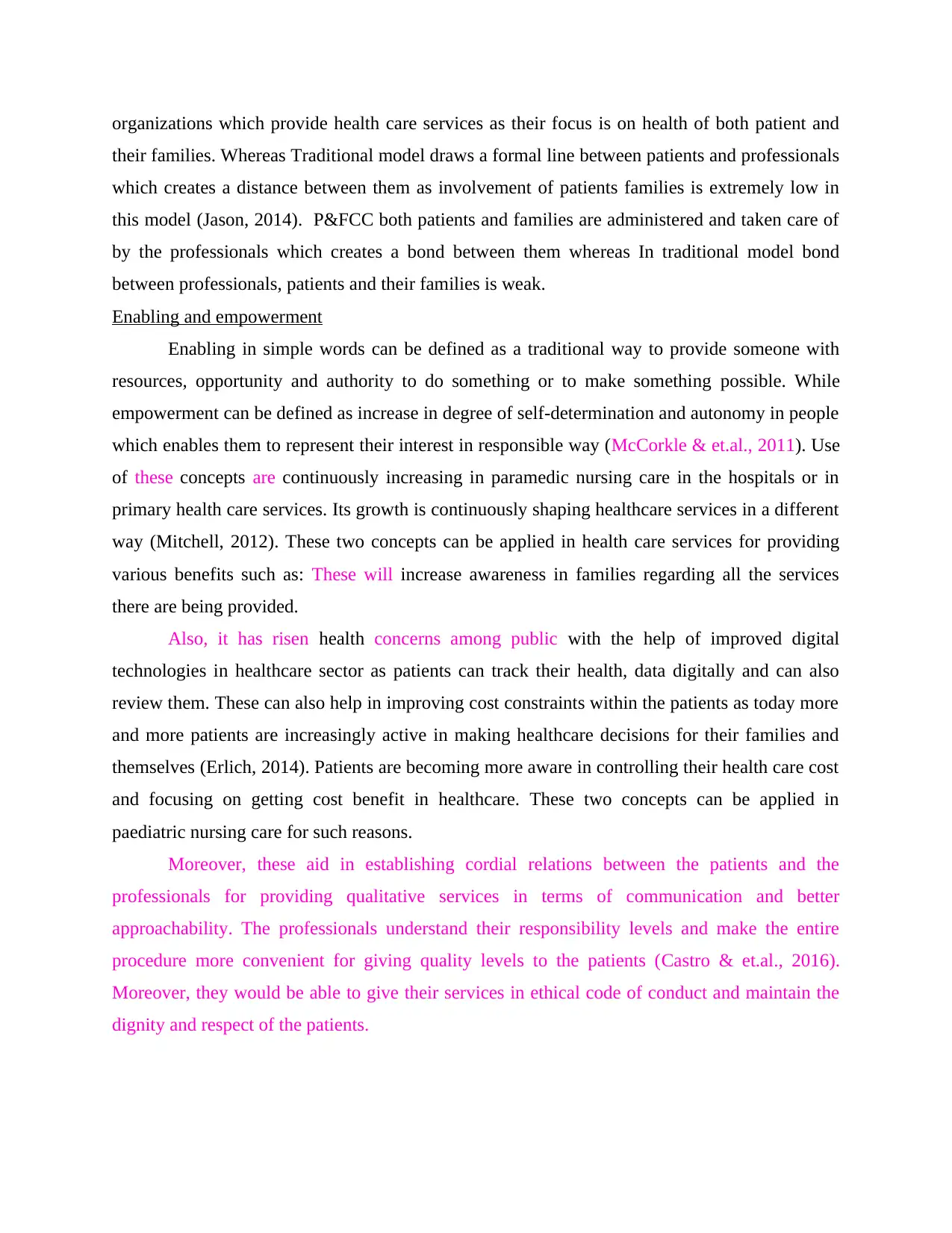
organizations which provide health care services as their focus is on health of both patient and
their families. Whereas Traditional model draws a formal line between patients and professionals
which creates a distance between them as involvement of patients families is extremely low in
this model (Jason, 2014). P&FCC both patients and families are administered and taken care of
by the professionals which creates a bond between them whereas In traditional model bond
between professionals, patients and their families is weak.
Enabling and empowerment
Enabling in simple words can be defined as a traditional way to provide someone with
resources, opportunity and authority to do something or to make something possible. While
empowerment can be defined as increase in degree of self-determination and autonomy in people
which enables them to represent their interest in responsible way (McCorkle & et.al., 2011). Use
of these concepts are continuously increasing in paramedic nursing care in the hospitals or in
primary health care services. Its growth is continuously shaping healthcare services in a different
way (Mitchell, 2012). These two concepts can be applied in health care services for providing
various benefits such as: These will increase awareness in families regarding all the services
there are being provided.
Also, it has risen health concerns among public with the help of improved digital
technologies in healthcare sector as patients can track their health, data digitally and can also
review them. These can also help in improving cost constraints within the patients as today more
and more patients are increasingly active in making healthcare decisions for their families and
themselves (Erlich, 2014). Patients are becoming more aware in controlling their health care cost
and focusing on getting cost benefit in healthcare. These two concepts can be applied in
paediatric nursing care for such reasons.
Moreover, these aid in establishing cordial relations between the patients and the
professionals for providing qualitative services in terms of communication and better
approachability. The professionals understand their responsibility levels and make the entire
procedure more convenient for giving quality levels to the patients (Castro & et.al., 2016).
Moreover, they would be able to give their services in ethical code of conduct and maintain the
dignity and respect of the patients.
their families. Whereas Traditional model draws a formal line between patients and professionals
which creates a distance between them as involvement of patients families is extremely low in
this model (Jason, 2014). P&FCC both patients and families are administered and taken care of
by the professionals which creates a bond between them whereas In traditional model bond
between professionals, patients and their families is weak.
Enabling and empowerment
Enabling in simple words can be defined as a traditional way to provide someone with
resources, opportunity and authority to do something or to make something possible. While
empowerment can be defined as increase in degree of self-determination and autonomy in people
which enables them to represent their interest in responsible way (McCorkle & et.al., 2011). Use
of these concepts are continuously increasing in paramedic nursing care in the hospitals or in
primary health care services. Its growth is continuously shaping healthcare services in a different
way (Mitchell, 2012). These two concepts can be applied in health care services for providing
various benefits such as: These will increase awareness in families regarding all the services
there are being provided.
Also, it has risen health concerns among public with the help of improved digital
technologies in healthcare sector as patients can track their health, data digitally and can also
review them. These can also help in improving cost constraints within the patients as today more
and more patients are increasingly active in making healthcare decisions for their families and
themselves (Erlich, 2014). Patients are becoming more aware in controlling their health care cost
and focusing on getting cost benefit in healthcare. These two concepts can be applied in
paediatric nursing care for such reasons.
Moreover, these aid in establishing cordial relations between the patients and the
professionals for providing qualitative services in terms of communication and better
approachability. The professionals understand their responsibility levels and make the entire
procedure more convenient for giving quality levels to the patients (Castro & et.al., 2016).
Moreover, they would be able to give their services in ethical code of conduct and maintain the
dignity and respect of the patients.
Paraphrase This Document
Need a fresh take? Get an instant paraphrase of this document with our AI Paraphraser
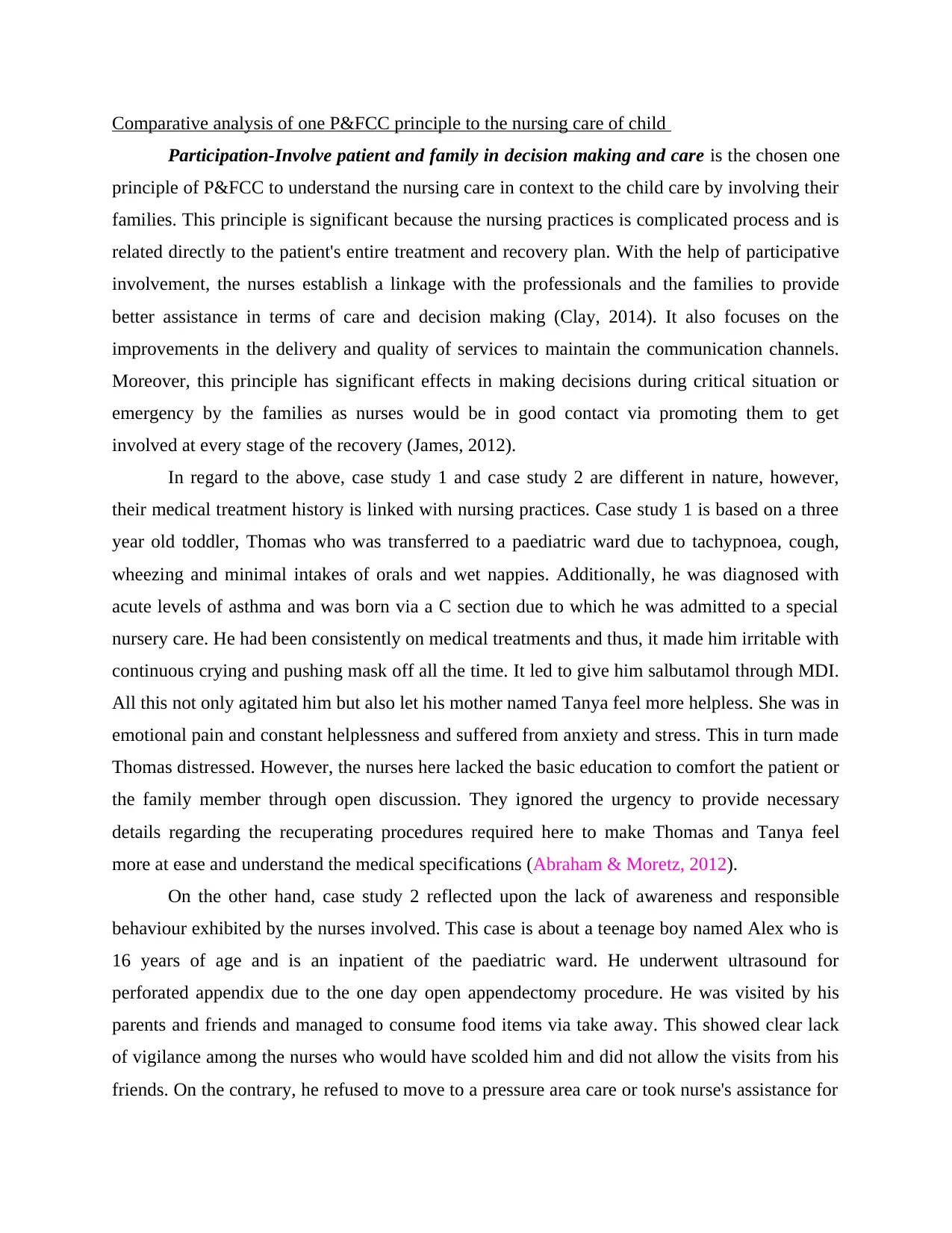
Comparative analysis of one P&FCC principle to the nursing care of child
Participation-Involve patient and family in decision making and care is the chosen one
principle of P&FCC to understand the nursing care in context to the child care by involving their
families. This principle is significant because the nursing practices is complicated process and is
related directly to the patient's entire treatment and recovery plan. With the help of participative
involvement, the nurses establish a linkage with the professionals and the families to provide
better assistance in terms of care and decision making (Clay, 2014). It also focuses on the
improvements in the delivery and quality of services to maintain the communication channels.
Moreover, this principle has significant effects in making decisions during critical situation or
emergency by the families as nurses would be in good contact via promoting them to get
involved at every stage of the recovery (James, 2012).
In regard to the above, case study 1 and case study 2 are different in nature, however,
their medical treatment history is linked with nursing practices. Case study 1 is based on a three
year old toddler, Thomas who was transferred to a paediatric ward due to tachypnoea, cough,
wheezing and minimal intakes of orals and wet nappies. Additionally, he was diagnosed with
acute levels of asthma and was born via a C section due to which he was admitted to a special
nursery care. He had been consistently on medical treatments and thus, it made him irritable with
continuous crying and pushing mask off all the time. It led to give him salbutamol through MDI.
All this not only agitated him but also let his mother named Tanya feel more helpless. She was in
emotional pain and constant helplessness and suffered from anxiety and stress. This in turn made
Thomas distressed. However, the nurses here lacked the basic education to comfort the patient or
the family member through open discussion. They ignored the urgency to provide necessary
details regarding the recuperating procedures required here to make Thomas and Tanya feel
more at ease and understand the medical specifications (Abraham & Moretz, 2012).
On the other hand, case study 2 reflected upon the lack of awareness and responsible
behaviour exhibited by the nurses involved. This case is about a teenage boy named Alex who is
16 years of age and is an inpatient of the paediatric ward. He underwent ultrasound for
perforated appendix due to the one day open appendectomy procedure. He was visited by his
parents and friends and managed to consume food items via take away. This showed clear lack
of vigilance among the nurses who would have scolded him and did not allow the visits from his
friends. On the contrary, he refused to move to a pressure area care or took nurse's assistance for
Participation-Involve patient and family in decision making and care is the chosen one
principle of P&FCC to understand the nursing care in context to the child care by involving their
families. This principle is significant because the nursing practices is complicated process and is
related directly to the patient's entire treatment and recovery plan. With the help of participative
involvement, the nurses establish a linkage with the professionals and the families to provide
better assistance in terms of care and decision making (Clay, 2014). It also focuses on the
improvements in the delivery and quality of services to maintain the communication channels.
Moreover, this principle has significant effects in making decisions during critical situation or
emergency by the families as nurses would be in good contact via promoting them to get
involved at every stage of the recovery (James, 2012).
In regard to the above, case study 1 and case study 2 are different in nature, however,
their medical treatment history is linked with nursing practices. Case study 1 is based on a three
year old toddler, Thomas who was transferred to a paediatric ward due to tachypnoea, cough,
wheezing and minimal intakes of orals and wet nappies. Additionally, he was diagnosed with
acute levels of asthma and was born via a C section due to which he was admitted to a special
nursery care. He had been consistently on medical treatments and thus, it made him irritable with
continuous crying and pushing mask off all the time. It led to give him salbutamol through MDI.
All this not only agitated him but also let his mother named Tanya feel more helpless. She was in
emotional pain and constant helplessness and suffered from anxiety and stress. This in turn made
Thomas distressed. However, the nurses here lacked the basic education to comfort the patient or
the family member through open discussion. They ignored the urgency to provide necessary
details regarding the recuperating procedures required here to make Thomas and Tanya feel
more at ease and understand the medical specifications (Abraham & Moretz, 2012).
On the other hand, case study 2 reflected upon the lack of awareness and responsible
behaviour exhibited by the nurses involved. This case is about a teenage boy named Alex who is
16 years of age and is an inpatient of the paediatric ward. He underwent ultrasound for
perforated appendix due to the one day open appendectomy procedure. He was visited by his
parents and friends and managed to consume food items via take away. This showed clear lack
of vigilance among the nurses who would have scolded him and did not allow the visits from his
friends. On the contrary, he refused to move to a pressure area care or took nurse's assistance for
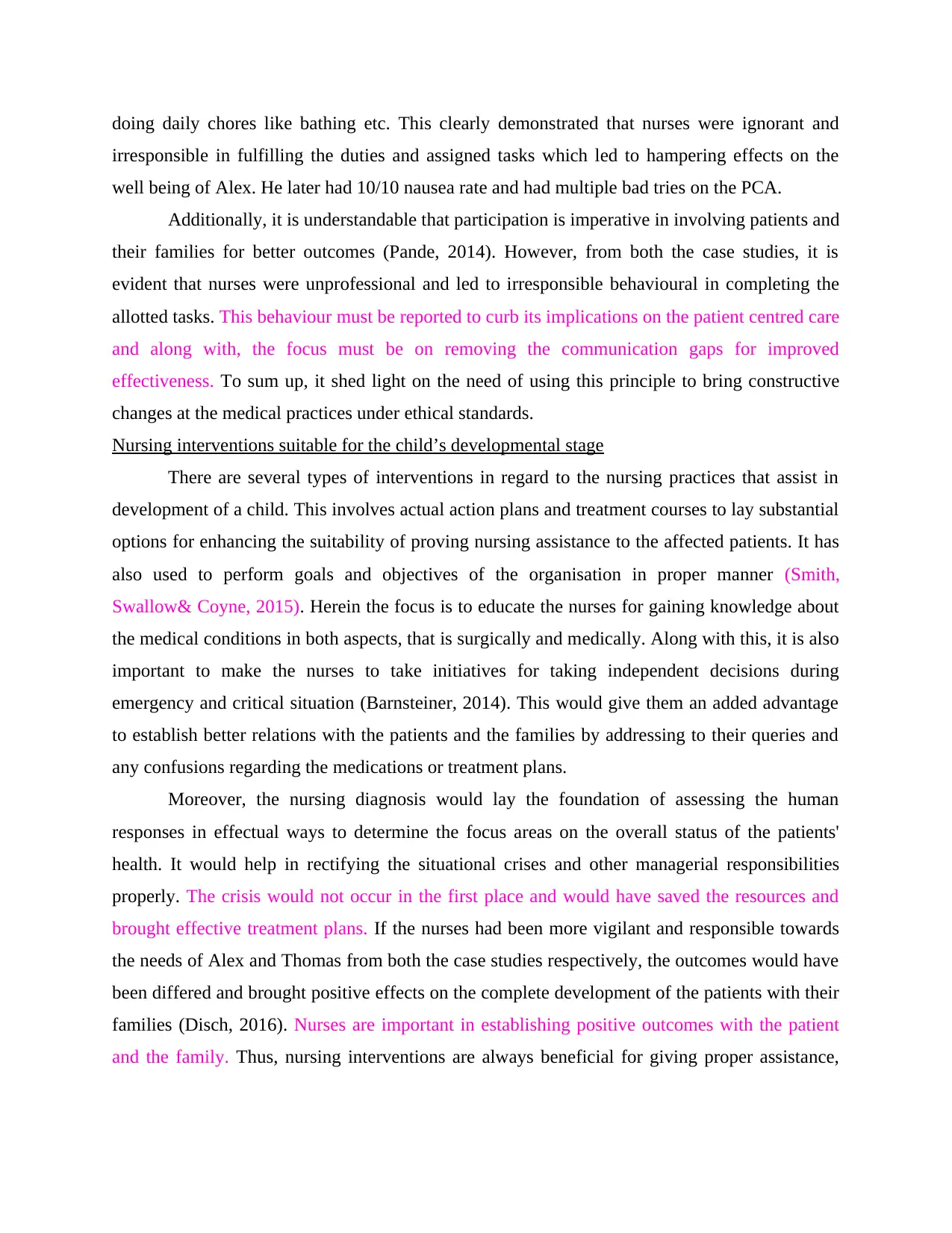
doing daily chores like bathing etc. This clearly demonstrated that nurses were ignorant and
irresponsible in fulfilling the duties and assigned tasks which led to hampering effects on the
well being of Alex. He later had 10/10 nausea rate and had multiple bad tries on the PCA.
Additionally, it is understandable that participation is imperative in involving patients and
their families for better outcomes (Pande, 2014). However, from both the case studies, it is
evident that nurses were unprofessional and led to irresponsible behavioural in completing the
allotted tasks. This behaviour must be reported to curb its implications on the patient centred care
and along with, the focus must be on removing the communication gaps for improved
effectiveness. To sum up, it shed light on the need of using this principle to bring constructive
changes at the medical practices under ethical standards.
Nursing interventions suitable for the child’s developmental stage
There are several types of interventions in regard to the nursing practices that assist in
development of a child. This involves actual action plans and treatment courses to lay substantial
options for enhancing the suitability of proving nursing assistance to the affected patients. It has
also used to perform goals and objectives of the organisation in proper manner (Smith,
Swallow& Coyne, 2015). Herein the focus is to educate the nurses for gaining knowledge about
the medical conditions in both aspects, that is surgically and medically. Along with this, it is also
important to make the nurses to take initiatives for taking independent decisions during
emergency and critical situation (Barnsteiner, 2014). This would give them an added advantage
to establish better relations with the patients and the families by addressing to their queries and
any confusions regarding the medications or treatment plans.
Moreover, the nursing diagnosis would lay the foundation of assessing the human
responses in effectual ways to determine the focus areas on the overall status of the patients'
health. It would help in rectifying the situational crises and other managerial responsibilities
properly. The crisis would not occur in the first place and would have saved the resources and
brought effective treatment plans. If the nurses had been more vigilant and responsible towards
the needs of Alex and Thomas from both the case studies respectively, the outcomes would have
been differed and brought positive effects on the complete development of the patients with their
families (Disch, 2016). Nurses are important in establishing positive outcomes with the patient
and the family. Thus, nursing interventions are always beneficial for giving proper assistance,
irresponsible in fulfilling the duties and assigned tasks which led to hampering effects on the
well being of Alex. He later had 10/10 nausea rate and had multiple bad tries on the PCA.
Additionally, it is understandable that participation is imperative in involving patients and
their families for better outcomes (Pande, 2014). However, from both the case studies, it is
evident that nurses were unprofessional and led to irresponsible behavioural in completing the
allotted tasks. This behaviour must be reported to curb its implications on the patient centred care
and along with, the focus must be on removing the communication gaps for improved
effectiveness. To sum up, it shed light on the need of using this principle to bring constructive
changes at the medical practices under ethical standards.
Nursing interventions suitable for the child’s developmental stage
There are several types of interventions in regard to the nursing practices that assist in
development of a child. This involves actual action plans and treatment courses to lay substantial
options for enhancing the suitability of proving nursing assistance to the affected patients. It has
also used to perform goals and objectives of the organisation in proper manner (Smith,
Swallow& Coyne, 2015). Herein the focus is to educate the nurses for gaining knowledge about
the medical conditions in both aspects, that is surgically and medically. Along with this, it is also
important to make the nurses to take initiatives for taking independent decisions during
emergency and critical situation (Barnsteiner, 2014). This would give them an added advantage
to establish better relations with the patients and the families by addressing to their queries and
any confusions regarding the medications or treatment plans.
Moreover, the nursing diagnosis would lay the foundation of assessing the human
responses in effectual ways to determine the focus areas on the overall status of the patients'
health. It would help in rectifying the situational crises and other managerial responsibilities
properly. The crisis would not occur in the first place and would have saved the resources and
brought effective treatment plans. If the nurses had been more vigilant and responsible towards
the needs of Alex and Thomas from both the case studies respectively, the outcomes would have
been differed and brought positive effects on the complete development of the patients with their
families (Disch, 2016). Nurses are important in establishing positive outcomes with the patient
and the family. Thus, nursing interventions are always beneficial for giving proper assistance,
⊘ This is a preview!⊘
Do you want full access?
Subscribe today to unlock all pages.

Trusted by 1+ million students worldwide
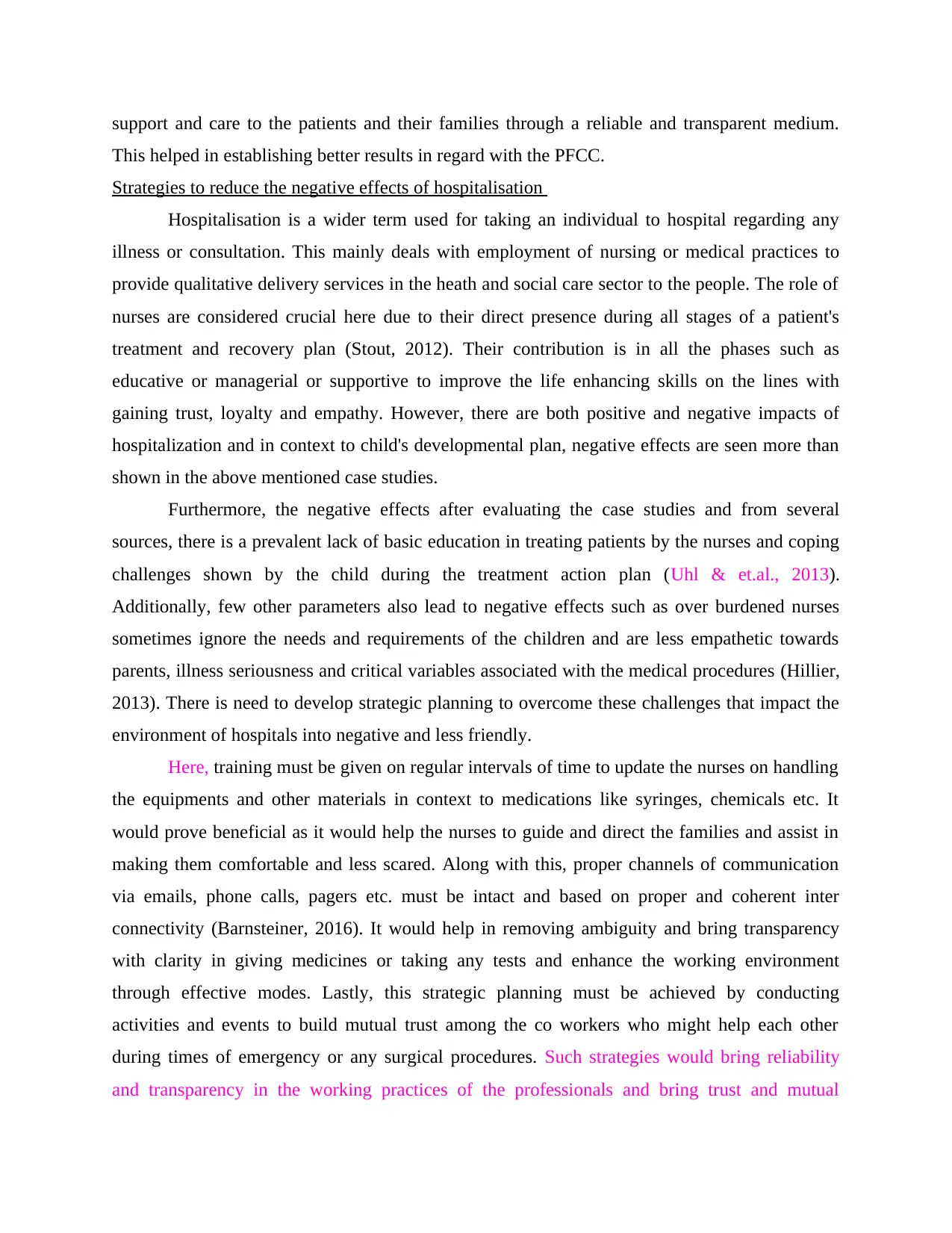
support and care to the patients and their families through a reliable and transparent medium.
This helped in establishing better results in regard with the PFCC.
Strategies to reduce the negative effects of hospitalisation
Hospitalisation is a wider term used for taking an individual to hospital regarding any
illness or consultation. This mainly deals with employment of nursing or medical practices to
provide qualitative delivery services in the heath and social care sector to the people. The role of
nurses are considered crucial here due to their direct presence during all stages of a patient's
treatment and recovery plan (Stout, 2012). Their contribution is in all the phases such as
educative or managerial or supportive to improve the life enhancing skills on the lines with
gaining trust, loyalty and empathy. However, there are both positive and negative impacts of
hospitalization and in context to child's developmental plan, negative effects are seen more than
shown in the above mentioned case studies.
Furthermore, the negative effects after evaluating the case studies and from several
sources, there is a prevalent lack of basic education in treating patients by the nurses and coping
challenges shown by the child during the treatment action plan (Uhl & et.al., 2013).
Additionally, few other parameters also lead to negative effects such as over burdened nurses
sometimes ignore the needs and requirements of the children and are less empathetic towards
parents, illness seriousness and critical variables associated with the medical procedures (Hillier,
2013). There is need to develop strategic planning to overcome these challenges that impact the
environment of hospitals into negative and less friendly.
Here, training must be given on regular intervals of time to update the nurses on handling
the equipments and other materials in context to medications like syringes, chemicals etc. It
would prove beneficial as it would help the nurses to guide and direct the families and assist in
making them comfortable and less scared. Along with this, proper channels of communication
via emails, phone calls, pagers etc. must be intact and based on proper and coherent inter
connectivity (Barnsteiner, 2016). It would help in removing ambiguity and bring transparency
with clarity in giving medicines or taking any tests and enhance the working environment
through effective modes. Lastly, this strategic planning must be achieved by conducting
activities and events to build mutual trust among the co workers who might help each other
during times of emergency or any surgical procedures. Such strategies would bring reliability
and transparency in the working practices of the professionals and bring trust and mutual
This helped in establishing better results in regard with the PFCC.
Strategies to reduce the negative effects of hospitalisation
Hospitalisation is a wider term used for taking an individual to hospital regarding any
illness or consultation. This mainly deals with employment of nursing or medical practices to
provide qualitative delivery services in the heath and social care sector to the people. The role of
nurses are considered crucial here due to their direct presence during all stages of a patient's
treatment and recovery plan (Stout, 2012). Their contribution is in all the phases such as
educative or managerial or supportive to improve the life enhancing skills on the lines with
gaining trust, loyalty and empathy. However, there are both positive and negative impacts of
hospitalization and in context to child's developmental plan, negative effects are seen more than
shown in the above mentioned case studies.
Furthermore, the negative effects after evaluating the case studies and from several
sources, there is a prevalent lack of basic education in treating patients by the nurses and coping
challenges shown by the child during the treatment action plan (Uhl & et.al., 2013).
Additionally, few other parameters also lead to negative effects such as over burdened nurses
sometimes ignore the needs and requirements of the children and are less empathetic towards
parents, illness seriousness and critical variables associated with the medical procedures (Hillier,
2013). There is need to develop strategic planning to overcome these challenges that impact the
environment of hospitals into negative and less friendly.
Here, training must be given on regular intervals of time to update the nurses on handling
the equipments and other materials in context to medications like syringes, chemicals etc. It
would prove beneficial as it would help the nurses to guide and direct the families and assist in
making them comfortable and less scared. Along with this, proper channels of communication
via emails, phone calls, pagers etc. must be intact and based on proper and coherent inter
connectivity (Barnsteiner, 2016). It would help in removing ambiguity and bring transparency
with clarity in giving medicines or taking any tests and enhance the working environment
through effective modes. Lastly, this strategic planning must be achieved by conducting
activities and events to build mutual trust among the co workers who might help each other
during times of emergency or any surgical procedures. Such strategies would bring reliability
and transparency in the working practices of the professionals and bring trust and mutual
Paraphrase This Document
Need a fresh take? Get an instant paraphrase of this document with our AI Paraphraser
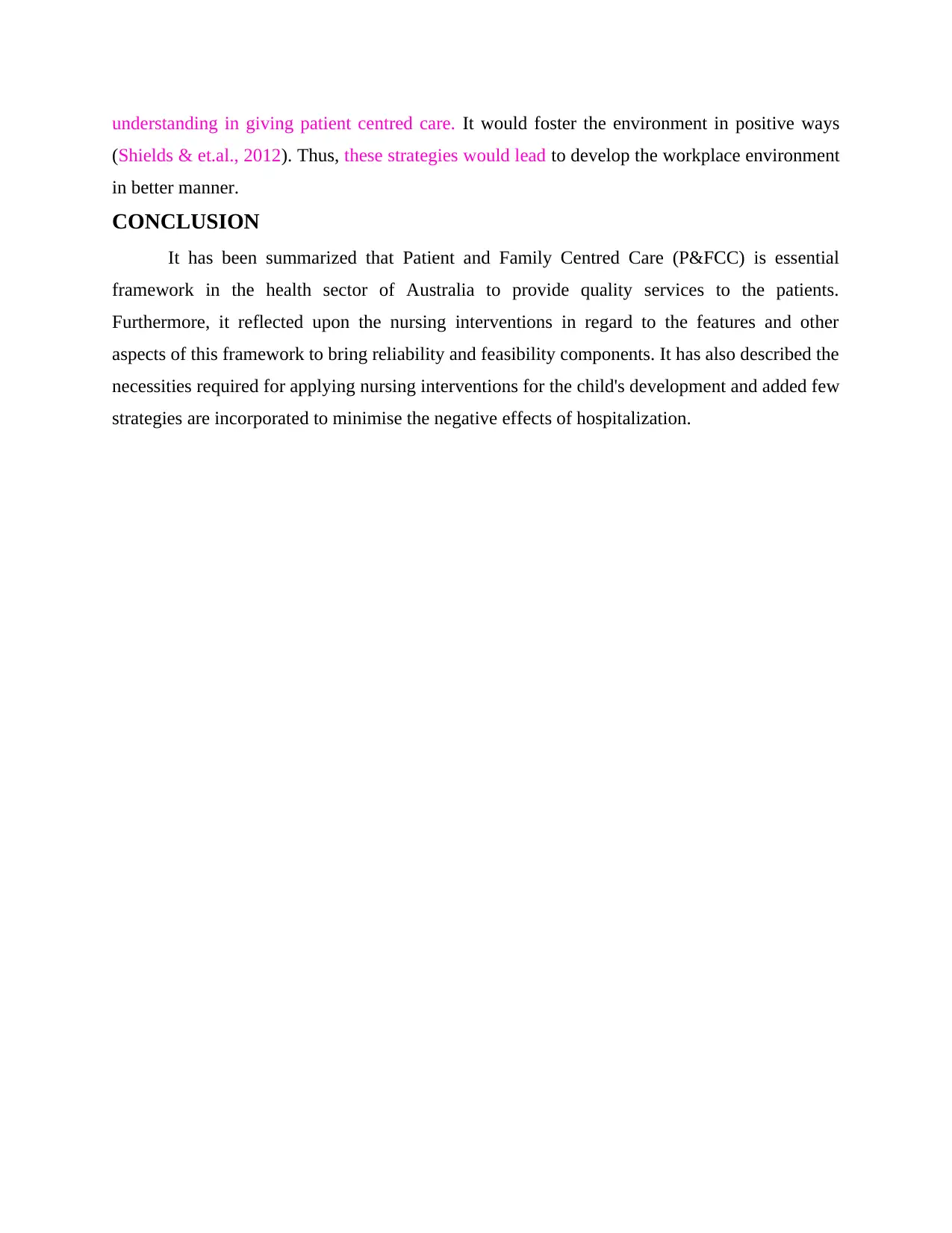
understanding in giving patient centred care. It would foster the environment in positive ways
(Shields & et.al., 2012). Thus, these strategies would lead to develop the workplace environment
in better manner.
CONCLUSION
It has been summarized that Patient and Family Centred Care (P&FCC) is essential
framework in the health sector of Australia to provide quality services to the patients.
Furthermore, it reflected upon the nursing interventions in regard to the features and other
aspects of this framework to bring reliability and feasibility components. It has also described the
necessities required for applying nursing interventions for the child's development and added few
strategies are incorporated to minimise the negative effects of hospitalization.
(Shields & et.al., 2012). Thus, these strategies would lead to develop the workplace environment
in better manner.
CONCLUSION
It has been summarized that Patient and Family Centred Care (P&FCC) is essential
framework in the health sector of Australia to provide quality services to the patients.
Furthermore, it reflected upon the nursing interventions in regard to the features and other
aspects of this framework to bring reliability and feasibility components. It has also described the
necessities required for applying nursing interventions for the child's development and added few
strategies are incorporated to minimise the negative effects of hospitalization.
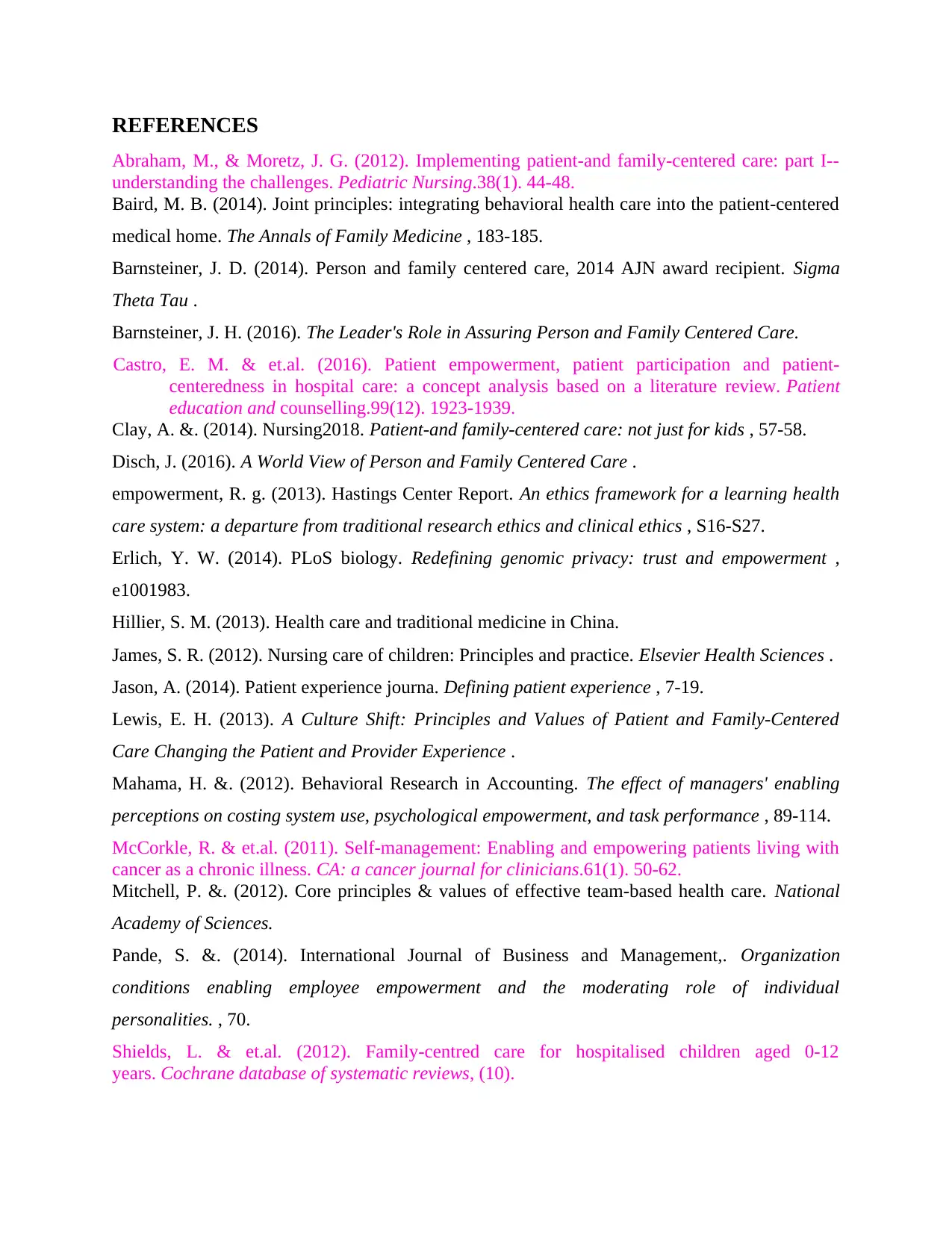
REFERENCES
Abraham, M., & Moretz, J. G. (2012). Implementing patient-and family-centered care: part I--
understanding the challenges. Pediatric Nursing.38(1). 44-48.
Baird, M. B. (2014). Joint principles: integrating behavioral health care into the patient-centered
medical home. The Annals of Family Medicine , 183-185.
Barnsteiner, J. D. (2014). Person and family centered care, 2014 AJN award recipient. Sigma
Theta Tau .
Barnsteiner, J. H. (2016). The Leader's Role in Assuring Person and Family Centered Care.
Castro, E. M. & et.al. (2016). Patient empowerment, patient participation and patient-
centeredness in hospital care: a concept analysis based on a literature review. Patient
education and counselling.99(12). 1923-1939.
Clay, A. &. (2014). Nursing2018. Patient-and family-centered care: not just for kids , 57-58.
Disch, J. (2016). A World View of Person and Family Centered Care .
empowerment, R. g. (2013). Hastings Center Report. An ethics framework for a learning health
care system: a departure from traditional research ethics and clinical ethics , S16-S27.
Erlich, Y. W. (2014). PLoS biology. Redefining genomic privacy: trust and empowerment ,
e1001983.
Hillier, S. M. (2013). Health care and traditional medicine in China.
James, S. R. (2012). Nursing care of children: Principles and practice. Elsevier Health Sciences .
Jason, A. (2014). Patient experience journa. Defining patient experience , 7-19.
Lewis, E. H. (2013). A Culture Shift: Principles and Values of Patient and Family-Centered
Care Changing the Patient and Provider Experience .
Mahama, H. &. (2012). Behavioral Research in Accounting. The effect of managers' enabling
perceptions on costing system use, psychological empowerment, and task performance , 89-114.
McCorkle, R. & et.al. (2011). Self‐management: Enabling and empowering patients living with
cancer as a chronic illness. CA: a cancer journal for clinicians.61(1). 50-62.
Mitchell, P. &. (2012). Core principles & values of effective team-based health care. National
Academy of Sciences.
Pande, S. &. (2014). International Journal of Business and Management,. Organization
conditions enabling employee empowerment and the moderating role of individual
personalities. , 70.
Shields, L. & et.al. (2012). Family‐centred care for hospitalised children aged 0‐12
years. Cochrane database of systematic reviews, (10).
Abraham, M., & Moretz, J. G. (2012). Implementing patient-and family-centered care: part I--
understanding the challenges. Pediatric Nursing.38(1). 44-48.
Baird, M. B. (2014). Joint principles: integrating behavioral health care into the patient-centered
medical home. The Annals of Family Medicine , 183-185.
Barnsteiner, J. D. (2014). Person and family centered care, 2014 AJN award recipient. Sigma
Theta Tau .
Barnsteiner, J. H. (2016). The Leader's Role in Assuring Person and Family Centered Care.
Castro, E. M. & et.al. (2016). Patient empowerment, patient participation and patient-
centeredness in hospital care: a concept analysis based on a literature review. Patient
education and counselling.99(12). 1923-1939.
Clay, A. &. (2014). Nursing2018. Patient-and family-centered care: not just for kids , 57-58.
Disch, J. (2016). A World View of Person and Family Centered Care .
empowerment, R. g. (2013). Hastings Center Report. An ethics framework for a learning health
care system: a departure from traditional research ethics and clinical ethics , S16-S27.
Erlich, Y. W. (2014). PLoS biology. Redefining genomic privacy: trust and empowerment ,
e1001983.
Hillier, S. M. (2013). Health care and traditional medicine in China.
James, S. R. (2012). Nursing care of children: Principles and practice. Elsevier Health Sciences .
Jason, A. (2014). Patient experience journa. Defining patient experience , 7-19.
Lewis, E. H. (2013). A Culture Shift: Principles and Values of Patient and Family-Centered
Care Changing the Patient and Provider Experience .
Mahama, H. &. (2012). Behavioral Research in Accounting. The effect of managers' enabling
perceptions on costing system use, psychological empowerment, and task performance , 89-114.
McCorkle, R. & et.al. (2011). Self‐management: Enabling and empowering patients living with
cancer as a chronic illness. CA: a cancer journal for clinicians.61(1). 50-62.
Mitchell, P. &. (2012). Core principles & values of effective team-based health care. National
Academy of Sciences.
Pande, S. &. (2014). International Journal of Business and Management,. Organization
conditions enabling employee empowerment and the moderating role of individual
personalities. , 70.
Shields, L. & et.al. (2012). Family‐centred care for hospitalised children aged 0‐12
years. Cochrane database of systematic reviews, (10).
⊘ This is a preview!⊘
Do you want full access?
Subscribe today to unlock all pages.

Trusted by 1+ million students worldwide
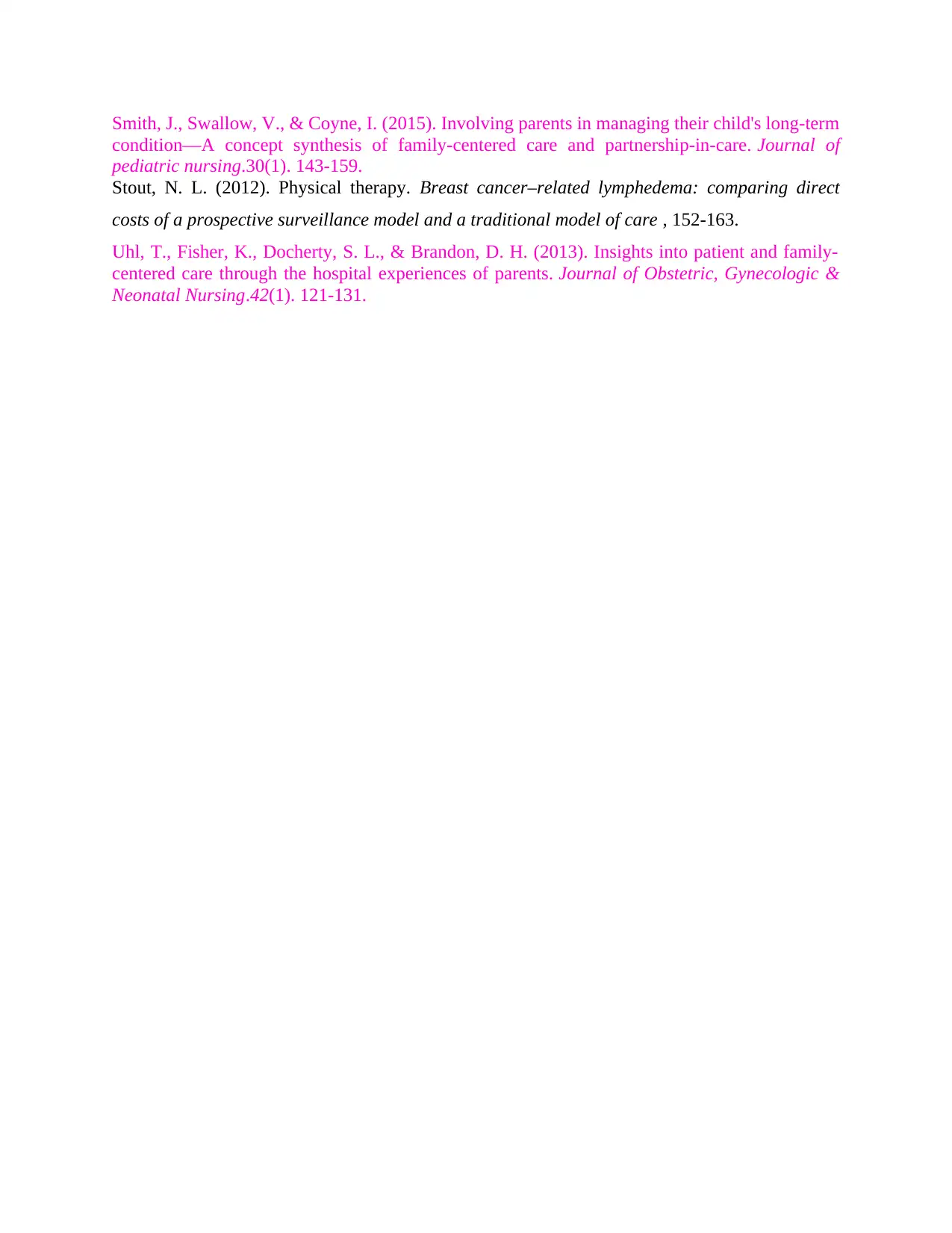
Smith, J., Swallow, V., & Coyne, I. (2015). Involving parents in managing their child's long-term
condition—A concept synthesis of family-centered care and partnership-in-care. Journal of
pediatric nursing.30(1). 143-159.
Stout, N. L. (2012). Physical therapy. Breast cancer–related lymphedema: comparing direct
costs of a prospective surveillance model and a traditional model of care , 152-163.
Uhl, T., Fisher, K., Docherty, S. L., & Brandon, D. H. (2013). Insights into patient and family‐
centered care through the hospital experiences of parents. Journal of Obstetric, Gynecologic &
Neonatal Nursing.42(1). 121-131.
condition—A concept synthesis of family-centered care and partnership-in-care. Journal of
pediatric nursing.30(1). 143-159.
Stout, N. L. (2012). Physical therapy. Breast cancer–related lymphedema: comparing direct
costs of a prospective surveillance model and a traditional model of care , 152-163.
Uhl, T., Fisher, K., Docherty, S. L., & Brandon, D. H. (2013). Insights into patient and family‐
centered care through the hospital experiences of parents. Journal of Obstetric, Gynecologic &
Neonatal Nursing.42(1). 121-131.
Paraphrase This Document
Need a fresh take? Get an instant paraphrase of this document with our AI Paraphraser


⊘ This is a preview!⊘
Do you want full access?
Subscribe today to unlock all pages.

Trusted by 1+ million students worldwide
1 out of 12
Related Documents
Your All-in-One AI-Powered Toolkit for Academic Success.
+13062052269
info@desklib.com
Available 24*7 on WhatsApp / Email
![[object Object]](/_next/static/media/star-bottom.7253800d.svg)
Unlock your academic potential
Copyright © 2020–2025 A2Z Services. All Rights Reserved. Developed and managed by ZUCOL.





